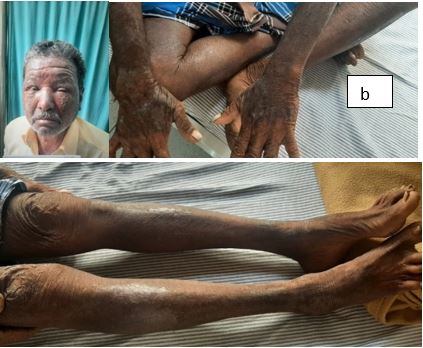Ayurvedic management of Vicharchika (Eczema) - A Case Report
DOI:
https://doi.org/10.21760/jaims.8.6.37Keywords:
Eczema, Vicharchika, Parisheka, Abhyanga, Siravyadha, Case report.Abstract
Eczema is a reaction pattern manifested by variable clinical and histologic findings. Primary lesions may include papules, erythematous macules and vesicles which can coalesce to form patches and plaques. In severe eczema, secondary lesions such as weeping and crusting may predominate. Eczema has quite resemblance with Vicharchika in Ayurveda. Vicharchika is characterized by skin manifestation having the symptoms Kandu (Itching sensation), Pidika (Papule), Shyava Varna (Blackish brown discoloration) and Bahusrava (Excessive exudation). Case summary: A 62 year old male patient approached with chief complaints of diffuse scaly skin lesions over face, upper limbs, lower limbs, abdomen and flanks associated with severe itching and serous discharge since 8 months. The Ayurvedic diagnosis was made as Vicharchika (Eczema) on the basis of signs and symptoms. The patient was given with Raktha Shodhaka and Kushtahara Shamana Aushadis (Oral medications) along with Parisheka (Sudation by shower sprinkling) with Sidharthaka Snana Choorna as Sravahara line of management. Later on Sadyovirechana was administered for Koshta Shudhi. From the 7th day Abhyanga (Oil massage) was started and on 11th day of treatment Siravyadha (Bloodletting) was done. Significant improvement was observed after 14 days of treatment in terms of EASI Score. This case study shows that Ayurvedic treatment is helpful in effective management of Vicharchika and helps in improving the quality of life.
Downloads
References
Robert A Swerlick, Thomas J Lawley. Eczema, Psoriasis, Cutaneous Infections, Acne and other common skin disorders. In: Isselbacher, Wilson, Martin et.al. Harrison’s principles of internal medicine. 13thed. International publication; Mc Graw-Hill;1994;274.
Berth Jones J. Eczema, lichenification, prurigo and erythroderma. In Burns T et al., eds. Rook’s textbook of Dermatology. 8th edition. UK: Blackwell Publishing Ltd; 2010. http://dx. doi.org/10.1002/9781444317633. Ch23 PMid:21812829.
Sharma RK, Dash Bhagwan. English translation on Cakrapani Datta’s Ayurveda Dipika on Agnivesa’s Caraka Samhita, Chikistasthana, Kushta chikista: Chapter 7, Verse 26, Varanasi: Chowkhamba Sanskrit series office, 2014 :325.
Sharma RK, Dash Bhagwan. English translation on Cakrapani Datta’s Ayurveda Dipika on Agnivesa’s Caraka Samhita, Sutrasthana, Vividha ashitapeethiya adhyaya: Chapter 28, Verse 11-12, Varanasi: Chowkhamba Sanskrit series office,2012 :576.
Murthy KRS, English translation on Astanga Hrdayam of Vagbhata. Chikitsasthana; Kushta chikitsa: Chapter 19, Verse 59-60. Varanasi: Chowkhamba Krishnadas Academy,2013:482.
Murthy KRS, English translation on Astanga Hrdayam of Vagbhata. Sutrasthana; Sveda vidhi: Chapter 17, Verse 30. Varansi: Chowkhamba Krishnadas Academy, 2013:56.
Murthy KRS, English translation on Astanga Hrdayam of Vagbhata. Sutrasthana; Vamana Virechanavidhi: Chapter 18, Verse 1. Varanasi: Chowkhamba Krishnadas Academy,2013:58.















